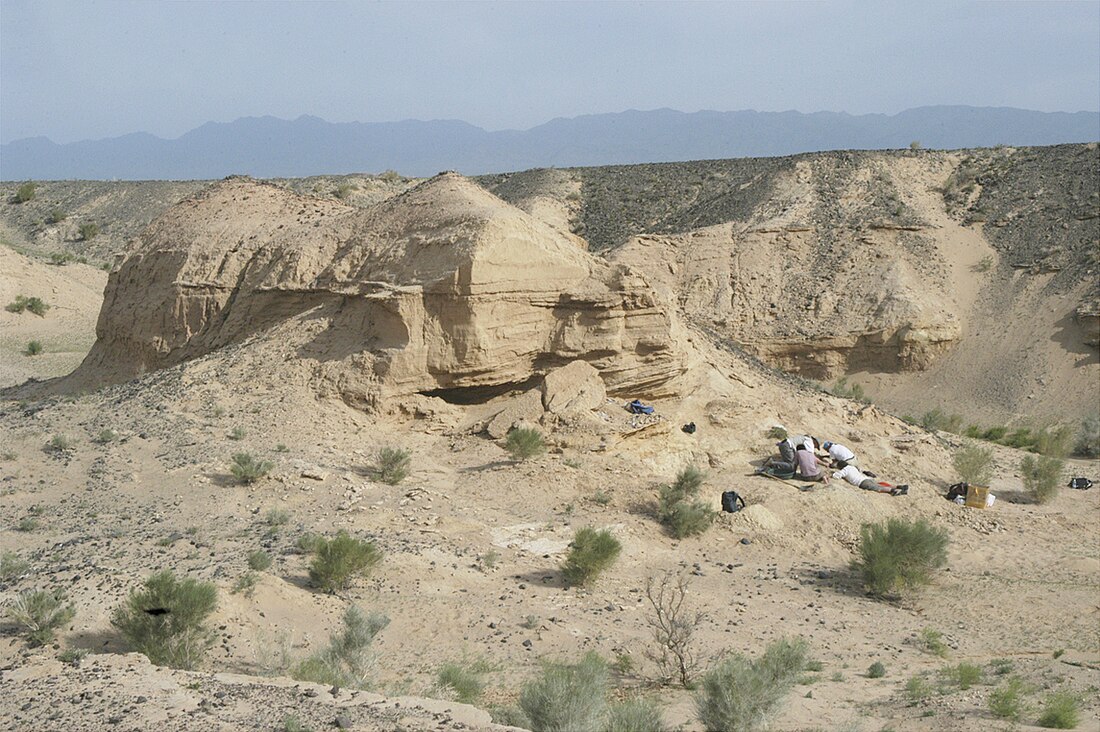Top Qs
Timeline
Chat
Perspective
Nemegt Formation
Geological formation in Mongolia From Wikipedia, the free encyclopedia
Remove ads
The Nemegt Formation (also known as Nemegtskaya Svita) is a geological formation in the Gobi Desert of Mongolia, dating to the Late Cretaceous. The formation consists of river channel sediments and contains fossils of fish, turtles, crocodilians, and a diverse fauna of dinosaurs, including birds.
Remove ads
Description
Summarize
Perspective
The Nemegt Formation is composed of mudstones and sandstones that were deposited by ancient lakes, streams, and flood plains. The Altan Uul locality was described by Michael Novacek as "a canyon carved out of a very rich series of sedimentary rocks" with "steep cliffs and narrow washes". The climate associated with it was wetter than when preceding formations were deposited; there seems to have existed at least some degree of forest cover as indicated by petrified fossil trunks. When examined, the rock facies of the upper section consist of braided meanders, and oxbow lakes. Alteration of sediment grades indicates frequent hydrodynamic condition changes (seasonal rain). Siltstone pellets indicate desiccation at the channel margins in river low-stand periods. Bank erosion features would form through river channel migration. Generally rivers consisted of low flow regimes with sporadic upper flow regimes indicated by exotic pebbles. The lower sections of the formation may represent Lacustrine or Palustrine deposition; perhaps the vestiges of an endorheic lake?[1] A study of oxygen-18 isotopes from Theropod teeth show seasonal patterns similar to present day continental climates. Mean annual temperatures are estimated to be around 7.6 °C (45.7 °F) with seasonal precipitation patterns compared to meteorological data from Shijiazhuang, China; suggesting a monsoonal, cold semi-arid climate.[2] The Nemegt environment was dominated by araucarian conifers,[2] but it also supported a diverse array of other plants, including ginkgos and a wide variety of angiosperms—ranging from plane trees (sycamores) to duckweeds.[3] The groundcover included quillwort like plants as well as sedges (members of the group Cyperaceae).[3] Grass is also known from the formation, and as in the Laramie Formation of North America,[4] reed grasses (primarily Phragmites) were present.[5] The area also supported Bald Cypress.[5] The area probably resembled the modern day Okavango Delta in Botswana.[6]
Remove ads
Stratigraphy
Summarize
Perspective

The most recent stratigraphy divides the Nemegt Formation into three informal members. The lower member is dominated by fluvial deposits, while middle and upper members consist of alluvial plain, paludal, lacustrine, and fluvial deposits. The colour of the sediments is usually light grey to tan in colour in comparison to the typically red colour of the underlying Barun Goyot Formation.[7] It overlies and sometimes interfingers with the Barun Goyot Formation. Interfingering has been noted at the stratotype (Red Walls) and Hermiin Tsav.[7] There has been no absolute dating of the Nemegt Formation. Historically the Nemegt has been considered late Campanian to Maastrichtian, based on comparisons of fossils present, but no exact dating has been performed. U-Pb dating from teeth of Tarbosaurus may support a deposition of the middle–upper Nemegt Formation at 66.7 ± 2.5 Ma, during the Maastrichtian age. Together with other faunal composition evidence, this suggests that the Nemegt deposition may have begun in the late Campanian to early Maastrichtian age.[8]
While it has been generally assumed that the Djadokhta, Baruungoyot, and Nemegt formations were layered in succession, some geological analysis suggested interfingering rather than superposition of these features. Thus these formations could represent different parts of a single interconnected ecosystem, with the Djadokhta reflecting arid dune habitats dominated by small animals, the Baruungoyot representing transitional semi-arid zones, and the Nemegt capturing wetter river plains that supported large dinosaurs.[9]
Remove ads
Paleobiota of the Nemegt Formation
Summarize
Perspective
Stratigraphic positions are based on Eberth (2018) who correlated localities to their approximate position within the formation.[7]
Color key
|
Notes Uncertain or tentative taxa are in small text; |
Amphibians
Crocodylomorphs
Fish
Flora
Invertebrates
Mammals
Pterosaurs
Turtles
Dinosaurs
Ornithischians
Ankylosaurs
Hadrosaurs
Pachycephalosaurs
Sauropods
Theropods
Alvarezsaurs
Birds
Dromaeosaurs
Ornithomimosaurs
Oviraptorosaurs
Therizinosaurs
Troodontids
Tyrannosaurs
Remove ads
See also
References
Wikiwand - on
Seamless Wikipedia browsing. On steroids.
Remove ads

















































